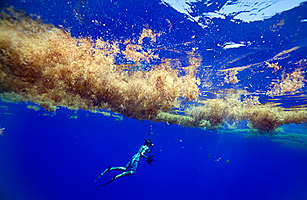
(3 of 4)
Parks of the Sea
MPAS aren't a new idea. Countries have been giving some protection to priceless pieces of the ocean, like Australia's Great Barrier Reef, for years. The MPAs have even been growing in number recently. In 2006, President George W. Bush created the Papahanaumokuakea Marine National Monument in northwestern Hawaii, protecting nearly 140,000 sq. mi. of ocean, and this year Britain created the largest MPA in the world, around the Chagos Archipelago in the Indian Ocean. Studies have shown that MPAs can allow fish and coral to recover from exploitation, and they have spillover benefits for unprotected waters outside their borders. But MPAs still make up just a tiny fraction of total ocean area, and in most of them, fishing is still allowed. (Imagine if hunting were permitted in Yellowstone Park and you have an idea of the difference between land conservation and its blue counterpart.) And there is virtually no protection for the high seas, the 64% of the oceans that is beyond the jurisdiction of any single nation. (Governments have claim to the waters in their exclusive economic zones, extending 200 miles beyond their coastlines.) Though there are a number of global bodies that deal with parts of the high seas, from regional fishery organizations to the International Seabed Authority, there's no clear way to create reserves in international waters. "The high seas are the least protected areas in the world," says Elliott Norse, head of the Marine Conservation Biology Institute.
That's why Earle has decided to focus on creating MPAs in the high seas, the heart of the ocean. As part of her prize, she received support from TED to form Mission Blue and launched it with a special TED conference held on board a ship off the Galápagos Islands this April. (She chose the Galápagos for more than just the scenery. Although 97% of the islands' land is strictly protected, just 3% of the surrounding ocean is, and the difference shows.) Philanthropists, venture capitalists and celebrities — including the greenish actors Edward Norton and Leonardo DiCaprio — listened to marine scientists and environmentalists detail the global ocean crisis; the result was $17 million in commitments for a number of initiatives, including the creation of the first real high-seas MPA, in the Sargasso. "This is new territory for all of us," says Dan Laffoley, marine vice chair for the International Union for Conservation of Nature's World Commission on Protected Areas. "The Sargasso Sea could provide a road map for creating more protection elsewhere."
That's because the Sargasso has one feature going for it that Earle's other hope spots — which range from the Gakkel Ridge in the Arctic to the Ross Sea off Antarctica — lack: Bermuda. The 21-sq.-mi. island, a British overseas territory, has a long history of acting for ocean conservation, having passed a law in 1620 prohibiting the killing of young sea turtles. "We look at the sea every day," says Phillipe Rouja, acting director of Bermuda's department of conservation services. "You can't tell us that we don't care about it." Though conservationists still need further approval and support from other nations bordering the Sargasso Sea — including the U.S. and Britain — Bermuda's leadership has helped the idea take off. And if Earle's vision catches on and other nations start working together to put aside open ocean, Bermudan officials believe that leading the charge could pay political and economic dividends for their people, as well as for the planet. "We are absolutely interested in saving the Sargasso Sea," says Ewart Brown, Bermuda's Premier. "We're in the perfect location for Bermuda to become the center of this."
Thanks to the work of scientists at the Bermuda Institute of Ocean Sciences (BIOS), one of the oldest oceanographic institutes in the world, parts of the Sargasso Sea have been more closely studied than almost anywhere else in the open ocean. And there's something magical about the Sargasso, a symbol of borderless mystery. The European and American eels hatch in the Sargasso Sea, then travel to coastal and inland waters, in one of the most enigmatic migrations in the natural world, before returning to the sargassum to spawn and die. And while its remoteness has so far saved the Sargasso Sea from the damage done to other parts of the ocean, there are emerging threats, including the risk that the sargassum might be harvested for biofuel or fertilizer, robbing this aquatic nursery of its cradles.